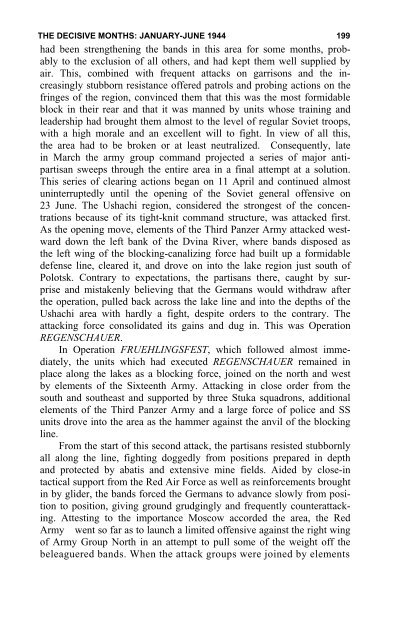the soviet partisan movement 1941-1944 by edgar m. howell
the soviet partisan movement 1941-1944 by edgar m. howell
the soviet partisan movement 1941-1944 by edgar m. howell
Create successful ePaper yourself
Turn your PDF publications into a flip-book with our unique Google optimized e-Paper software.
THE DECISIVE MONTHS: JANUARY-JUNE <strong>1944</strong> 199<br />
had been streng<strong>the</strong>ning <strong>the</strong> bands in this area for some months, probably<br />
to <strong>the</strong> exclusion of all o<strong>the</strong>rs, and had kept <strong>the</strong>m well supplied <strong>by</strong><br />
air. This, combined with frequent attacks on garrisons and <strong>the</strong> increasingly<br />
stubborn resistance offered patrols and probing actions on <strong>the</strong><br />
fringes of <strong>the</strong> region, convinced <strong>the</strong>m that this was <strong>the</strong> most formidable<br />
block in <strong>the</strong>ir rear and that it was manned <strong>by</strong> units whose training and<br />
leadership had brought <strong>the</strong>m almost to <strong>the</strong> level of regular Soviet troops,<br />
with a high morale and an excellent will to fight. In view of all this,<br />
<strong>the</strong> area had to be broken or at least neutralized. Consequently, late<br />
in March <strong>the</strong> army group command projected a series of major anti<strong>partisan</strong><br />
sweeps through <strong>the</strong> entire area in a final attempt at a solution.<br />
This series of clearing actions began on 11 April and continued almost<br />
uninterruptedly until <strong>the</strong> opening of <strong>the</strong> Soviet general offensive on<br />
23 June. The Ushachi region, considered <strong>the</strong> strongest of <strong>the</strong> concentrations<br />
because of its tight-knit command structure, was attacked first.<br />
As <strong>the</strong> opening move, elements of <strong>the</strong> Third Panzer Army attacked westward<br />
down <strong>the</strong> left bank of <strong>the</strong> Dvina River, where bands disposed as<br />
<strong>the</strong> left wing of <strong>the</strong> blocking-canalizing force had built up a formidable<br />
defense line, cleared it, and drove on into <strong>the</strong> lake region just south of<br />
Polotsk. Contrary to expectations, <strong>the</strong> <strong>partisan</strong>s <strong>the</strong>re, caught <strong>by</strong> surprise<br />
and mistakenly believing that <strong>the</strong> Germans would withdraw after<br />
<strong>the</strong> operation, pulled back across <strong>the</strong> lake line and into <strong>the</strong> depths of <strong>the</strong><br />
Ushachi area with hardly a fight, despite orders to <strong>the</strong> contrary. The<br />
attacking force consolidated its gains and dug in. This was Operation<br />
REGENSCHAUER.<br />
In Operation FRUEHLINGSFEST, which followed almost immediately,<br />
<strong>the</strong> units which had executed REGENSCHAUER remained in<br />
place along <strong>the</strong> lakes as a blocking force, joined on <strong>the</strong> north and west<br />
<strong>by</strong> elements of <strong>the</strong> Sixteenth Army. Attacking in close order from <strong>the</strong><br />
south and sou<strong>the</strong>ast and supported <strong>by</strong> three Stuka squadrons, additional<br />
elements of <strong>the</strong> Third Panzer Army and a large force of police and SS<br />
units drove into <strong>the</strong> area as <strong>the</strong> hammer against <strong>the</strong> anvil of <strong>the</strong> blocking<br />
line.<br />
From <strong>the</strong> start of this second attack, <strong>the</strong> <strong>partisan</strong>s resisted stubbornly<br />
all along <strong>the</strong> line, fighting doggedly from positions prepared in depth<br />
and protected <strong>by</strong> abatis and extensive mine fields. Aided <strong>by</strong> close-in<br />
tactical support from <strong>the</strong> Red Air Force as well as reinforcements brought<br />
in <strong>by</strong> glider, <strong>the</strong> bands forced <strong>the</strong> Germans to advance slowly from position<br />
to position, giving ground grudgingly and frequently counterattacking.<br />
Attesting to <strong>the</strong> importance Moscow accorded <strong>the</strong> area, <strong>the</strong> Red<br />
Army went so far as to launch a limited offensive against <strong>the</strong> right wing<br />
of Army Group North in an attempt to pull some of <strong>the</strong> weight off <strong>the</strong><br />
beleaguered bands. When <strong>the</strong> attack groups were joined <strong>by</strong> elements
















